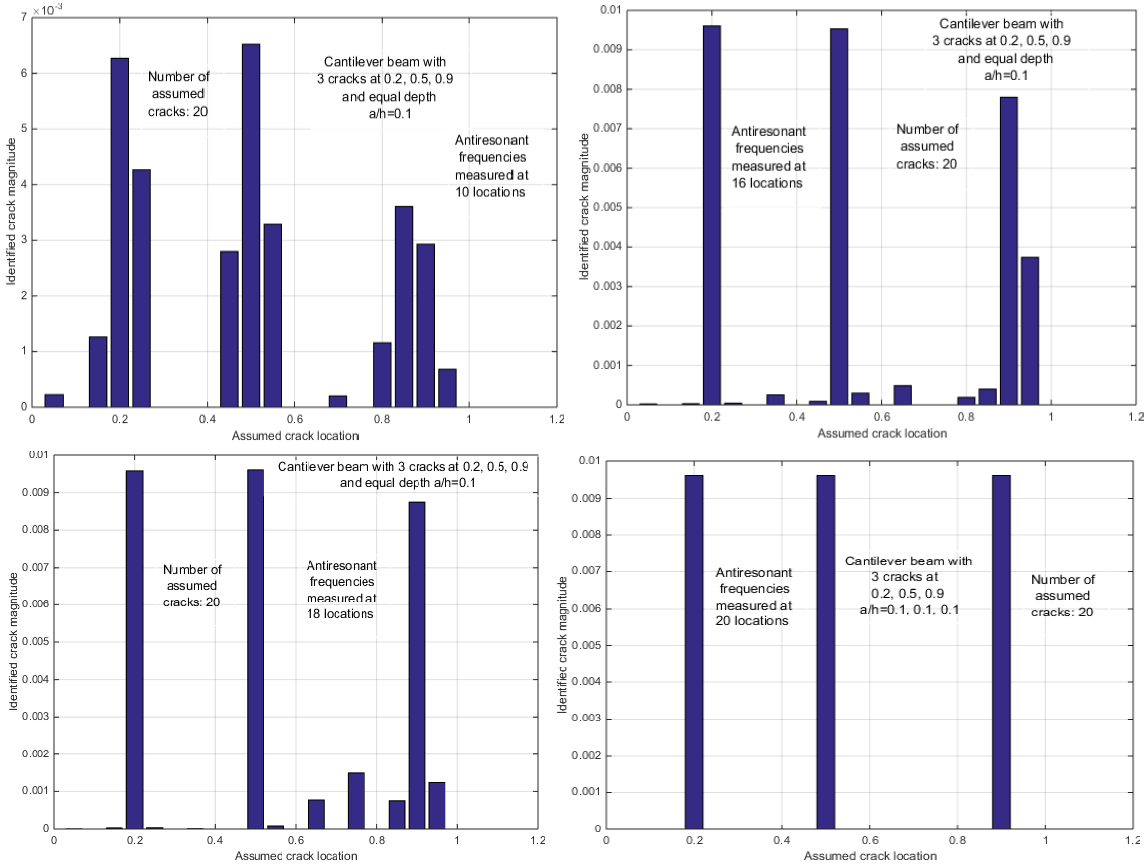Crack identification in beam by antiresonant frequencies
Author affiliations
DOI:
https://doi.org/10.15625/0866-7136/16710Keywords:
cracked beam, antiresonant frequency, crack identificationAbstract
The present paper deals with the concept of antiresonance in multiple cracked beams and application for multi-crack identification. First, governing equations for antiresonant frequency are conducted and used for both computing antiresonant frequencies versus crack parameters and measuring-loading colocation and identifying cracks by measured antiresonant frequencies. Then, a procedure is proposed for crack identification in cantilever beam by antiresonant frequencies based on the so-called crack scanning method. Theoretical development is illustrated by numerical examples.
Downloads
References
J. E. Mottershead and Y. M. Ram. Inverse eigenvalue problems in vibration absorption: Passive modification and active control. Mechanical Systems and Signal Processing, 20, (2006), pp. 5–44.
J. E. Mottershead, M. G. Tehrani, S. James, and Y. M. Ram. Active vibration suppression by pole-zero placement using measured receptances. Journal of Sound and Vibration, 311, (2008), pp. 1391–1408.
D. Richiedei and I. Tamellin. Active control of linear vibrating systems for antiresonance assignment with regional pole placement. Journal of Sound and Vibration, 494, (2021).
J. E. Mottershead. On the zeros of structural frequency response functions and their sensitivities. Mechanical Systems and Signal Processing, 12, (1998), pp. 591–597.
W. D’Ambrogio and A. Fregolent. The use of antiresonance for robust model updating. Journal of Sound and Vibration, 236, (2000), pp. 227–243.
K. Jones and J. Turcotte. Finite element model updating using antiresonant frequencies. Journal of Sound and Vibration, 252, (2002), pp. 717–727.
V. Meruane. Model updating using antiresonant frequencies identified from transmissibility functions. Journal of Sound and Vibration, 332, (2013), pp. 807–820.
F. Wahl, G. Schmidt, and L. Forrai. On the significance of antiresonance frequencies in experimental structure analysis. Journal of Sound and Vibration, 219, (1999), pp. 379–394.
D. Hanson, T. P. Waters, D. J. Thompson, R. B. Randall, and R. A. J. Ford. The role of anti-resonance frequencies from operational modal analysis in finite element model updating. Mechanical Systems and Signal Processing, 21, (2007), pp. 74–97.
T. Inada, Y. Shimamura, A. Todoroki, and H. Kobayashi. Development of the two-step delamination identification method by resonant and anti-resonant frequency changes. Key Engineering Materials, 270-273, (2004), pp. 1852–1858.
N. Dharmaraju and J. K. Sinha. Some comments on use of antiresonance for crack identification in beams. Journal of Sound and Vibration, 286, (2005), pp. 669–671.
W. Feng-Quan, H. Xiao-Ling, and G. Ying-Zheng. Analysis of the Characteristics of Pseudo-Resonance and Anti-Resonance. Journal of Vibration and Acoustics, 118, (1996), pp. 663–667.
Y. Bamnios, E. Douka, and A. Trochidis. Crack identification in beam structures using mechanical impedance. Journal of Sound and Vibration, 256, (2002), pp. 287–297.
D. S. Wang and H. P. Zhu. Wave propagation based multi-crack identification in beam structures through anti-resonances information. Key Engineering Materials, 293-294, (2005), pp. 557–564.
D. Wang, H. Zhu, C. Chen, and Y. Xia. An impedance analysis for crack detection in the Timoshenko beam based on the anti-resonance technique. Acta Mechanica Solida Sinica, 20, (2007), pp. 228–235.
M. Dilena and A. Morassi. Detecting cracks in a longitudinally vibrating beam with dissipative boundary conditions. Journal of Sound and Vibration, 267, (2003), pp. 87–103.
M. Dilena and A. Morassi. The use of antiresonances for crack detection in beams. Journal of Sound and Vibration, 276, (2004), pp. 195–214.
M. Dilena and A. Morassi. Structural health monitoring of rods based on natural frequency and antiresonant frequency measurements. Structural Health Monitoring, 8, (2009), pp. 149–173.
M. Dilena and A. Morassi. Reconstruction method for damage detection in beams based on natural frequency and antiresonant frequency measurements. Journal of Engineering Mechanics, 136, (2010), pp. 329–344.
V. Meruane and W. Heylen. Structural damage assessment with antiresonances versus mode shapes using parallel genetic algorithms. Structural Control and Health Monitoring, 18, (2010), pp. 825–839.
P. T. B. Lien and N. T. Khiem. Resonant and antiresonant frequencies of multiple cracked bar. Vietnam Journal of Mechanics, 41, (2019), pp. 157–170.
T. T. Hai, K. Nguyen, and P. T. B. Lien. Characteristic equation for antiresonant frequencies of multiple cracked bars and application for crack detection. Nondestructive Testing and Evaluation, 34, (2019), pp. 299–323.
N. T. Khiem and H. T. Tran. A procedure for multiple crack identification in beam-like structures from natural vibration mode. Journal of Vibration and Control, 20, (2013), pp. 1417–1427.
N. T. Khiem and L. K. Toan. A novel method for crack detection in beam-like structures by measurements of natural frequencies. Journal of Sound and Vibration, 333, (2014), pp. 4084–4103.

Downloads
Published
How to Cite
Issue
Section
License

This work is licensed under a Creative Commons Attribution-ShareAlike 4.0 International License.
Funding data
-
National Foundation for Science and Technology Development
Grant numbers 107.01-2019.312 -
Vietnam Academy of Science and Technology
Grant numbers NVCC03.04/21-21




